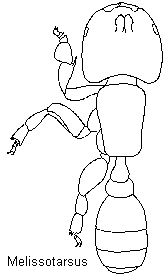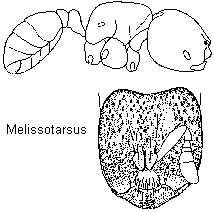
Home
Mission
Overview of Project
Project Staff
Sponsors
Achievements
Checking, Illustrations
Upcoming Activities
Id and Species Lists
Protea Information
Protea Gallery
Growing Proteas
Interim Dist. Maps
Publications
Afrikaanse Inligting
![]()
Silk Ant Discovered in Pincushion
| Brian L. Fisher - South African Museum In the Nardouw Mountains, 23 km NE of Clanwilliam, we discovered silk-producing ants, Melissotarsus emeryi Forel, nesting in live wood of Ls praemorsum! This is the first time silk production has been recorded in adult ants. It is also the first record of silk production at any life stage in the subfamily Myrmicinae. A loose network of silken material lines the gallery tunnels and is combined with wood particles to seal cracks in tunnel walls and to close exit holes. The silk is produced by adult workers from glands located below the head at the base of the mandibles. The ants apply the silk using their modified front legs, or "silk brushes". To seal gaps in the tunnel, the ant takes a wood fragment in her mandibles and draws silk out of the silk glands by lifting the forelegs alternately in a kneading fashion ("spinning"). The silk fibres are applied to the opening and wood fragment with the silk brush. When sufficient silk is applied, the wood fragment is pushed with the forelegs, forcing it out of the mouth into the gap. Spinning continues until the wood fragment forms part of the tunnel wall. |
 |
 |
The entire feeding area is also sealed
with silk. Workers are never seen wandering outside their
tunnels, not even to visit the extrafloral nectaries on
the leaves. If they fall out of the galleries, the
workers move awkwardly and have difficulty in turning
themselves off their backs. This is because the second
and third coxae are massively developed: the second being
distinctly the largest, and appears to limit leg movement
outside the tunnels. The ants are thus unique in walking
with the middle pair of legs pointing upwards in contact
with the tunnel roof, but this means they cannot walk
except in the tunnels. In addition, these ants farm a strange scale-insect inside the tunnels. Other ants farm scale-insects that produce honey-dew, but these scale-insects produces wax! Ants cannot live on wax (or so we thought). |
This Silk Ant is an anomaly. It possesses a peculiar morphology, nesting behaviour, manner of walking, and the unique capacity among adult workers of producing silk. The big question is why it produces silk? The production of silk may allow the silk ant to make use of the living wood habitat in a way not possible by other ant species, but at the cost of not being able to live outside of their tunnels.
Does the Silk Ant occur throughout the range of Ls praemorsum? Does it occur on the Pincushions? Look for the silk in the wood cracks, and crack open some dead wood to confirm their presence - the ants should not be able to "get up". Please send your observations to us!
Back Protea Ecology